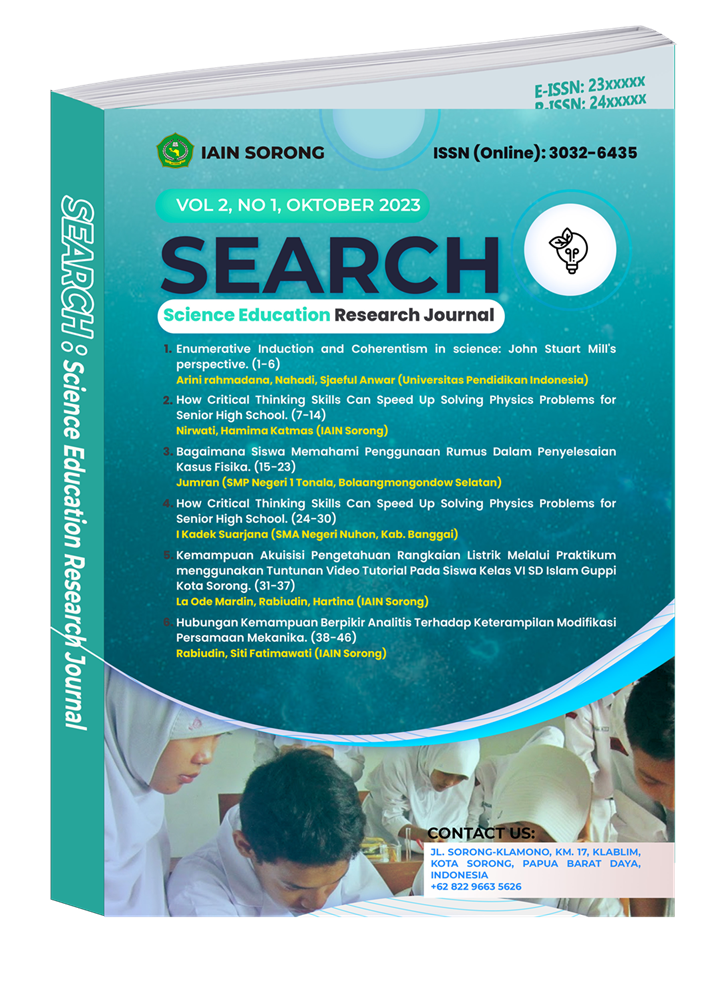Correlation between Critical Thinking Ability and the Quality of Students' Independent Assignments in Histology Course
DOI:
https://doi.org/10.47945/search.v4i`1.2133Keywords:
Critical Thinking, Independent Assignment, Histology, Biology education, correlationAbstract
Critical thinking skills are a key component required in completing independent tasks (Sukenda, 2016). This study aims to analyze correlation between students' critical thinking skills and the quality of independent assignments in Histology courses. The research method used was a correlational quantitative approach involving 35 Biology Education study program students who were taking Histology courses. Data were collected through a histology context-based critical thinking test and independent assignment assessment using an analysis rubric. The correlation test results showed a positive correlation between critical thinking skills and the quality of students' independent assignments (r = 0.244, p < 0.05). This finding indicates that although there is a positive correlation coefficient between critical thinking ability and independent assignment quality, the significance value (Sig.) of 0.157 indicates that the correlation is not statistically significant. Based on this data, it can be concluded that there is no significant correlation between students' critical thinking skills and the quality of their independent assignments in the Histology course.
References
Davidovitch, N., & Dorot, R. (2023). The Effect of Motivation for Learning Among High School Students and Undergraduate Students—A Comparative Study. International Education Studies, 16(2), 117. https://doi.org/10.5539/ies.v16n2p117
Desnita, D. (2022). Validity and Reliability of Critical Thinking Instruments to Measure the Effectiveness of Context-Based Physics E-Module on Wave Materials. Jurnal Penelitian & Pengembangan Pendidikan Fisika, 8(1), 57–64. https://doi.org/10.21009/1.08106
Ghafar, Z. N. (2023). The Impact of Critical Thinking on Learners to Increase their Self regulate in the Education Process: An Overview. International Journal of Arts and Humanities, 1(1), 23–30. https://doi.org/10.61424/ijah.v1i1.13
Golden, B. (2023). Enabling critical thinking development in higher education through the use of a structured planning tool. Irish Educational Studies, 42(4), 949–969. https://doi.org/10.1080/03323315.2023.2258497
Harrison, A., Evans, G., & Blanco, G. (2024). Expanding science skills: teaching tissue culture, data analysis, and reporting through imaging the actin cytoskeleton. Journal of Microbiology & Biology Education, 25(2). https://doi.org/10.1128/jmbe.00190-23
Hortsch, M. (2023). Histology as a paradigm for a science‐based learning experience: Visits by histology education spirits of past, present, and future. Anatomical Sciences Education, 16(3), 372–383. https://doi.org/10.1002/ase.2235
Kassiavera, S., Suparmi, A., Cari, C., & Sukarmin, S. (2024). APPLICATION OF RASCH MODEL IN TWO-TIER TEST FOR ASSESSING CRITICAL THINKING IN PHYSICS EDUCATION. Journal of Baltic Science Education, 23(6), 1227–1242. https://doi.org/10.33225/jbse/24.23.1227
Khatri, P., Duggal, H. K., Lim, W. M., Thomas, A., & Shiva, A. (2024). Student well-being in higher education: Scale development and validation with implications for management education. The International Journal of Management Education, 22(1), 100933. https://doi.org/10.1016/j.ijme.2024.100933
Kotzé, S. H., & Mole, C. G. (2015). Making large class basic histology lectures more interactive: The use of draw‐along mapping techniques and associated educational activities. Anatomical Sciences Education, 8(5), 463–470. https://doi.org/10.1002/ase.1514
McCormick, N. J., Clark, L. M., & Raines, J. M. (2015). Engaging Students in Critical Thinking and Problem Solving: A Brief Review of the Literature. Journal of Studies in Education, 5(4), 100. https://doi.org/10.5296/jse.v5i4.8249
Mohammedsaleh, Z. M. (2024). The Impact of Various Factors on the Difficulties in Learning and Teaching Strategies for Histology. International Journal of Morphology, 42(3), 741–748. https://doi.org/10.4067/s0717-95022024000300741
Ngatminiati, Y., Hidayah, Y., & Suhono. (2024). Keterampilan Berpikir Kritis untuk Memgembangkan Kompetensi Abad 21 Siswa Sekolah Dasar. Jurnal Review Pendidikan dan Pengajaran, 7(3), 8210–8216.
Nold, H. (2017). Using Critical Thinking Teaching Methods to Increase Student Success: An Action Research Project. International Journal of Teaching, 29(1), 17–32. http://www.isetl.org/ijtlhe/
Rahma, H. D., Alimuddin, & Andi, P. (2024). Higher Order Thinking and Critical Thinking Skills in Problem-Based Learning Environments: A Systematic Review. Journal of Learning and Development Studies, 4(2), 21–33. https://doi.org/10.32996/jlds.2024.2.2.3
Rusmin, L., Misrahayu, Y., Pongpalilu, F., Radiansyah, R., & Dwiyanto, D. (2024). Critical Thinking and Problem-Solving Skills in the 21st Century. Join: Journal of Social Science, 1(5), 144–162. https://doi.org/10.59613/svhy3576
Sukenda, E. A. (2016). Kemampuan Berpikir Kritis dan Kemandirian Belajar dengan Hasil Belajar Matematika. Jurnal Pendidikan dasar, 7(2), 185–198.
Ventista, O. M., & Brown, C. (2023). Teachers’ professional learning and its impact on students’ learning outcomes: Findings from a systematic review. Social Sciences & Humanities Open, 8(1), 100565. https://doi.org/10.1016/j.ssaho.2023.100565
Wani, S. A., & Hussian, Z. (2024). Developing Critical Thinking Skills: Encouraging Analytical and Creative Thinking. In Developing Critical Thinking Skills (pp. 114–130). https://doi.org/10.4018/979-8-3693-0868-4.ch007
Wiwikananda, S. K. S., & Susanti, A. (2022). Improving Students’ Critical Thinking Skills through Digital Storytelling on Narrative Text. Pioneer: Journal of Language and Literature, 14(2), 356. https://doi.org/10.36841/pioneer.v14i2.1685
Yusniar, Elpisah, & Syarifuddin. (2025). Effect of Critical Thinking, Learning Independence, and Gotong Royong in P5 Merdeka Curriculum. International Journal of Social Welfare and Family Law, 2(2), 23–35. https://doi.org/10.62951/ijsw.v2i2.306








